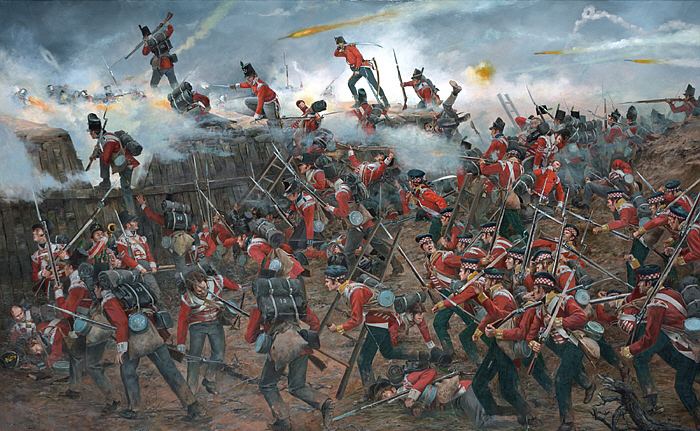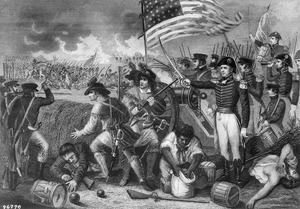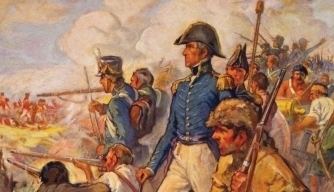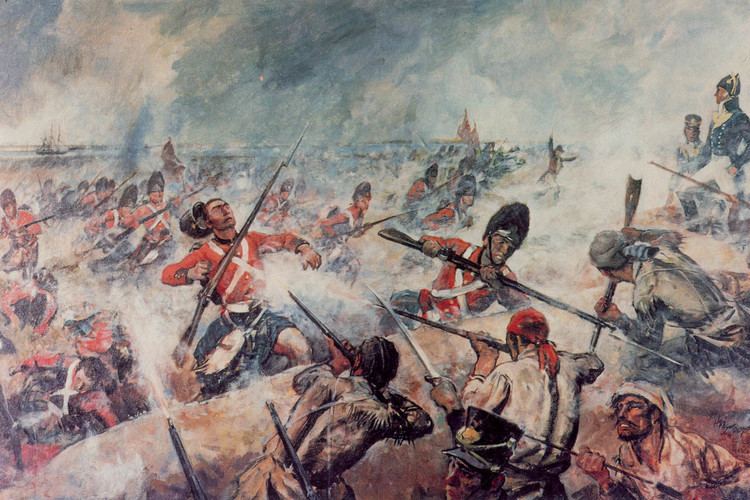4,732 14,450 | Dates 8 Jan 1815 – 26 Jan 1815 | |
 | ||
13 killed30 wounded19 missingTotal 62 285 killed1,265 wounded484 capturedTotal 2,034 Location Chalmette, St. Bernard Parish, Louisiana, Louisiana, United States Results Decisive American victory, British forces withdraw completely from Louisiana. Combatants United States of America, United Kingdom, Indigenous peoples of the North Similar War of 1812, Battle of Tippecanoe, Battle of Horseshoe Bend, Battle of Balti, Burning of Washington | ||
The Battle of New Orleans was an engagement fought between January 8 and January 18, 1815, constituting the final major battle of the War of 1812, and the most one-sided battle of that war. American combatants, commanded by Major General Andrew Jackson, prevented an overwhelming British force, commanded by Admiral Alexander Cochrane and General Edward Pakenham, from seizing New Orleans and the vast territory the United States had acquired with the Louisiana Purchase.
Contents
- Battle of Lake Borgne
- Night attack of December 23
- Battle of January 8
- Siege of Fort St Philip
- Withdrawal of the British
- Aftermath
- Victory attributed to a miracle
- In popular culture
- References

The Treaty of Ghent had been signed on December 24, 1814 (but was not ratified by the US Government until February 1815), and hostilities continued without the involved parties knowing about the Treaty, until January 18 by when all of the British forces had retreated, finally putting an end to the Battle of New Orleans.

Battle of Lake Borgne

By December 12, 1814, sixty British ships with 14,450 soldiers and sailors aboard, under the command of Admiral Sir Alexander Cochrane, had anchored in the Gulf of Mexico to the east of Lake Pontchartrain and Lake Borgne. Preventing access to the lakes was an American flotilla, commanded by Lieutenant Thomas ap Catesby Jones, consisting of five gunboats. On December 14, around 1,200 British sailors and Royal Marines under Captain Nicholas Lockyer set out to attack Jones' force. Lockyer's men sailed in 42 longboats, each armed with a small carronade. Lockyer captured Jones' vessels in a brief engagement known as the Battle of Lake Borgne. 17 British sailors were killed and 77 wounded, while 6 Americans were killed, 35 wounded, and 86 captured. The wounded included both Jones and Lockyer. Now free to navigate Lake Borgne, thousands of British soldiers, under the command of General John Keane, were rowed to Pea Island, about 30 miles (48 km) east of New Orleans, where they established a garrison.
Night attack of December 23

On the morning of December 23, Keane and a vanguard of 1,800 British soldiers reached the east bank of the Mississippi River, 9 miles (14 km) south of New Orleans. Keane could have attacked the city by advancing for a few hours up the river road, which was undefended all the way to New Orleans, but he made the fateful decision to encamp at Lacoste's Plantation and wait for the arrival of reinforcements. During the afternoon of December 23, after he had learned of the position of the British encampment, Andrew Jackson reportedly said, "By the Eternal they shall not sleep on our soil." This intelligence had been provided by Colonel Thomas Hinds' Squadron of Light Dragoons, a militia unit from the Mississippi Territory. That evening, attacking from the north, Jackson led 2,131 men in a brief three-pronged assault on the unsuspecting British troops, who were resting in their camp. Then Jackson pulled his forces back to the Rodriguez Canal, about 4 miles (6.4 km) south of the city. The Americans suffered 24 killed, 115 wounded, and 74 missing, while the British reported their losses as 46 killed, 167 wounded, and 64 missing.

Historian Robert Quimby says, "the British certainly did win a tactical victory, which enabled them to maintain their position." However, Quimby goes on to say, "It is not too much to say that it was the battle of December 23 that saved New Orleans. The British were disabused of their expectation of an easy conquest. The unexpected and severe attack made Keane even more cautious...he made no effort to advance on the twenty-fourth or twenty-fifth." As a consequence, the Americans were given time to begin the transformation of the canal into a heavily fortified earthwork. On Christmas Day, General Edward Pakenham arrived on the battlefield and ordered a reconnaissance-in-force on December 28 against the American earthworks protecting the advance to New Orleans. That evening, General Pakenham met with General Keane and Admiral Cochrane for an update on the situation, angry with the position that the army had been placed in. General Pakenham wanted to use Chef Menteur Road as the invasion route, but he was overruled by Admiral Cochrane, who insisted that his boats were providing everything that could be needed. Admiral Cochrane believed the veteran British soldiers would easily destroy Jackson's ramshackle army, and he allegedly said that if the army did not do it, his sailors would. Whatever Pakenham's thoughts on the matter, the meeting settled the method and place of the attack.

When the British reconnaissance-in-force withdrew, the Americans immediately began constructing earthworks to protect the artillery batteries. These defenses were then christened Line Jackson. The Americans installed eight batteries, which included one 32-pound gun, three 24-pounders, one 18-pounder, three 12-pounders, three 6-pounders, and a 6-inch (150 mm) howitzer. Jackson also sent a detachment to the west bank of the Mississippi to man two 24-pounders and two 12-pounders on the grounded warship USS Louisiana. Even so, Jackson's force was greatly outnumbered by the attacking forces. Jackson's total of 4,732 men was made up of 968 U.S. Army regulars, 58 U.S. Marines (holding the center of the defensive line), 106 seamen of the US Naval battalion, 1,060 Louisiana militia and volunteers (including 462 free people of color), 1,352 Tennessee militia, 986 Kentucky militia, 150 Mississippi militia, and 52 Choctaw warriors, along with a force from the pirate Jean Lafitte's Baratarians. Jackson also had the support of the warships in the Mississippi River, including the USS Louisiana, the USS Carolina and the Enterprise, a steamboat.
The main British army arrived on New Year's Day 1815, and opened fire on the earthworks with their artillery. This began an exchange of artillery fire that continued for three hours. Several of the American guns were destroyed or silenced, including the 32-pounder, a 24-pounder, and a 12-pounder, while some damage was done to the earthworks. The British artillery finally exhausted its ammunition, which caused Pakenham to cancel the attack. Pakenham did not know that his attack had come close to success, since the Americans defenders on the left of Line Jackson near the swamp had broken under the fire and abandoned their position. Pakenham decided to wait until his entire force of over 8,000 men to assemble before continuing his attack. The British regulars included the 4th, 7th, 21st, 43rd, 44th, 85th, 93rd (Highland) Regiments, a 500-man "demi-battalion" of the 95th Rifles, 14th Light Dragoons, and the 1st and 5th West Indies Regiments of several hundred black soldiers from the British West Indies colonies. Other troops included Native Americans of the Hitchiti tribe, led by Kinache.
Battle of January 8
On January 8, 1815, the British marched against General Andrew Jackson's lines of defense. The Americans had constructed three lines of defense, the forward one four miles in front of the city, was strongly entrenched at the Rodriquez Canal, which stretched from a swamp to the river, with a timber, loopholed breastwork and earthworks for artillery.
The British battle plan was for an attack against the 20-gun west bank battery, which would then both reduce the American artillery danger and enable those same guns to be turned on the American line which would assist a frontal attack against the defended line. In the early morning of January 8, Pakenham gave his final orders for the two-pronged assault against Jackson's position. Colonel William Thornton (of the 85th Regiment) was to cross the Mississippi during the night with his 780-strong force, move rapidly upriver and storm the battery commanded by Commodore Daniel Patterson on the flank of the main American entrenchments and then open an enfilade fire on Jackson's line with howitzers and rockets. Then, the main attack, directly against the earthworks manned by the vast majority of American troops, would be launched in two columns (along the river led by Keane and along the swamp line led by Major General Samuel Gibbs). The brigade commanded by Major General John Lambert was held in reserve.
A canal was dug by the British to enable 42 small boats to get to the river. Preparations for the attack had foundered early on the 8th, as the canal being dug by Cochrane's sailors collapsed and the dam made to divert the flow of the river into the canal failed, leaving the sailors to drag the boats of Col. Thornton's west bank assault force through deep mud and left the force starting off just before daybreak, 12 hours late. The frontal attack was not however postponed as it was hoped that the west bank would at least create a diversion, even if they had not succeeded in the assault.
The main attack began under darkness and a heavy fog, but as the British neared the main enemy line the fog lifted, exposing them to withering artillery fire. Lt-Col. Thomas Mullins, the British commander of the 44th (East Essex) Regiment of Foot, had forgotten the ladders and fascines needed to cross the eight-foot-deep and fifteen-foot-wide canal and scale the earthworks, and confusion evolved in the dark and fog as the British tried to close the gap. Most of the senior officers were killed or wounded, including Major General Samuel Gibbs, who was killed leading the main attack column on the right comprising the 4th, 21st, 44th and 5th West India Regiments, and Colonel Rennie who led a detachment of three light companies of the 7th, 43rd, and 93rd on the left by the river.
Possibly because of Thornton's delay in crossing the river and the withering artillery fire that might hit them from across the river, the 93rd Highlanders were ordered to leave Keane's assault column advancing along the river and move across the open field to join the main force on the right of the field. Keane fell wounded as he crossed the field with the 93rd. Rennie's men managed to attack and overrun an American advance redoubt next to the river, but without reinforcements they could neither hold the position nor successfully storm the main American line behind it. Within a few minutes, the American 7th Infantry arrived, moved forward, and fired upon the British in the captured redoubt: within half an hour, Rennie and nearly all of his men were dead. In the main attack on the right, the British infantrymen either flung themselves to the ground, huddled in the canal, or were mowed down by a combination of musket fire and grapeshot from the Americans. A handful made it to the top of the parapet on the right but were either killed or captured. The 95th Rifles had advanced in open skirmish order ahead of the main assault force and were concealed in the ditch below the parapet, unable to advance further without support.
The two large main assaults on the American position were repulsed. Pakenham and his second-in-command, Major General Samuel Gibbs, were fatally wounded while on horseback, by grapeshot fired from the earthworks. Major Wilkinson of the 21st Regiment reformed his lines and made a third assault. They were able to reach the entrenchments and attempted to scale them. Wilkinson made it to the top, before being shot. The Americans were amazed at his bravery and carried him behind the rampart. With most of their senior officers dead or wounded, the British soldiers, including the 93rd Highlanders, having no orders to advance further or retreat, stood out in the open and were shot apart with grapeshot from Line Jackson. General Lambert was in the reserve and took command. He gave the order for his reserve to advance and ordered the withdrawal of the army. The reserve was used to cover the retreat of what was left of the British army in the field.
The only British success of the battle was the delayed attack on the west bank of the Mississippi River, where Thornton's brigade, comprising the 85th Regiment and detachments from the Royal Navy and Royal Marines, attacked and overwhelmed the American line. The Navy detachment and the Marine detachment were led by Captain Rowland Money and Brevet Major Thomas Adair, respectively. Money was captain of HMS Trave, and Adair was the commanding officer of HMS Vengeur's detachment of Marines. The sides of the canal by which the boats were to be brought through to the Mississippi caved in and choked the passage, so that only enough got through to take over a half of Thornton’s force. With these, seven hundred in number, he crossed, but as he did not allow for the current, it carried him down about two miles below the proper landing place. Thornton’s brigade won their battle, but Colonel Thornton was dangerously wounded. This success, though a brilliant one, and a disgrace to the American arms, had no effect on the battle. Army casualties among the 85th Foot were: 2 dead, 1 captured, and 41 wounded. Royal Navy casualties were 2 dead, Captain Rowland Money and 18 seamen wounded. Royal Marine casualties were 2 dead, with 3 officers, 1 sergeant and 12 other ranks wounded. Though both Jackson and Commodore Patterson reported that the retreating forces had spiked their cannon, leaving no guns to turn on the Americans' main defense line, Major Mitchell's diary makes it clear this was not so, as he states he had "Commenced cleaning enemy's guns to form a battery to enfilade their lines on the left bank". General Lambert ordered his Chief of Artillery, Colonel Alexander Dickson, to assess the position. Dickson reported back that no fewer than 2,000 men would be needed to hold the position. General Lambert issued orders to withdraw after the defeat of their main army on the east bank and retreated, taking a few American prisoners and cannon with them. It was later learned that the Americans were so dismayed by the loss of this battery, which would be capable of inflicting such damage on their lines when the attack was renewed, that they were preparing to abandon the town, when they received the news that the British themselves were withdrawing.
The Battle of New Orleans was remarkable for both its brevity and lopsided lethality. In the space of twenty-five minutes, the British lost 700 killed, 1400 wounded, and 500 prisoners, a total loss of 2600 men; American losses were only seven killed and six wounded. Adjutant-general Robert Butler, in his official report to General Jackson a few days after the battle of the 8th, placed the losses of the British at 700 killed, 1400 wounded, and 500 prisoners – the total of 2600 casualties was almost one third the entire number the enemy admitted to have taken part in the contest of the day. After the battle was over, around 500 British soldiers who had pretended to be dead rose up and surrendered to the Americans. One bugle boy climbed a tree within 200 yards of the American line and played throughout the battle, with projectiles passing close to him. He was captured after the battle and considered a hero by the Americans.
Almost universal blame was assigned to Colonel Mullins, of the 44th Regiment, which was detailed under orders to prepare and have ready, and to carry to the front on the morning of the eighth, fascines and ladders with which to cross the ditch and scale the parapet, as the soldiers fought their way to the breastwork of the Americans. It was freely charged that the Colonel deserted his trust and at the moment of need was half a mile to the rear. It was then that Pakenham, learning of Mullins' conduct, placed himself at the head of the 44th and endeavored to lead them to the front with the implements needed to storm the works, when at around 500 yards away from the enemy front line, he fell wounded after being hit with grapeshot. On being assisted onto a horse, Pakenham was hit again and fell, this time mortally wounded.
Siege of Fort St. Philip
The British planned to sail up the Mississippi River; however Fort St. Philip stood in the way. On January 9, British naval forces attacked Fort St. Philip, which protected New Orleans from an amphibious assault from the Gulf of Mexico via the Mississippi River. The American forces, in addition to gunners working from privateer ships, were able to fend off the attacks. They withstood ten days of bombardment by cannon before the British ships withdrew on January 18, 1815.
Withdrawal of the British
Three days after the battle, General Lambert held a council of war where, despite just receiving the news that the battery on the west bank of the river had been captured, it was concluded that despite his request for reinforcements as well as a siege train, capturing New Orleans and continuing the Louisiana campaign would be too costly and thus agreed with his officers to withdraw. By January 19 the British camp at Villere's Plantation had been completely evacuated.
On February 4, 1815, the fleet, with all of the British troops aboard, set sail toward Mobile Bay, Alabama. The British army then attacked and captured Fort Bowyer at the mouth of Mobile Bay on February 12. The following day, the British army was making preparations to attack Mobile when news arrived of the peace treaty. General Jackson had made tentative plans to attack the British at Mobile and continue the war into Spanish Florida on the grounds the British were using it as a base. He carried out those plans for Florida much later. The treaty had been ratified by the British Parliament but would not be ratified by Congress and the President until mid-February. It did, however, resolve that hostilities should cease, and the British abandoned Fort Bowyer and sailed home to their base in the West Indies. Although the Battle of New Orleans had no influence on the terms of the Treaty of Ghent, the defeat at New Orleans did compel Britain to abide by the treaty.
However, it would have been problematic for the British to continue the war in North America because of Napoleon's escape from Elba on February 26, 1815, which ensured their forces were needed in Europe. Also, since the Treaty of Ghent did not specifically mention the vast territory America had acquired with the Louisiana Purchase, it only required both sides to give back those lands that had been taken from the other during the war.
Aftermath
From December 25, 1814, to January 26, 1815, British casualties during the Louisiana Campaign, apart from the assault on January 8, were 49 killed, 87 wounded and 4 missing. Thus, British casualties for the entire campaign totaled 2,459 with 386 killed, 1,521 wounded, and 552 missing. American casualties for the entire campaign totaled 333 with 55 killed, 185 wounded, and 93 missing.
Six currently active battalions of the Regular Army (2-7 Inf, 3-7 Inf, 1-5 FA, 1-6 FA, 1-1 Inf and 2-1 Inf) and one Mississippi Army National Guard regiment (155th Inf) are derived from American units that fought at the Battle of New Orleans.
Although the engagement was very small compared to other contemporary battles of 1815, such as the Battle of Waterloo, it was important for the meaning applied to it by Americans in general and Andrew Jackson in particular.
Americans believed that a vastly powerful British fleet and army had sailed for New Orleans (Jackson himself thought 25,000 troops were coming), and most expected the worst. The news of victory, one man recalled, "came upon the country like a clap of thunder in the clear azure vault of the firmament, and traveled with electromagnetic velocity, throughout the confines of the land." The battle boosted the reputation of Andrew Jackson and helped to propel him ultimately to the White House. The anniversary of the battle was celebrated as a national holiday for many years, called "The Eighth", following Jackson's election as President and ended after 1861 and it continues to be commemorated in south Louisiana.
In honor of Jackson, the newly organized Louisiana Historical Association dedicated its new Memorial Hall facility on January 8, 1891, the 76th anniversary of the Battle of New Orleans.
A federal park was established in 1907 to preserve the battlefield; today it features a monument and is part of Jean Lafitte National Historical Park and Preserve.
The 8th of January became a traditional American fiddle tune, honoring the date of the battle. More than a century later, the melody was used by Jimmie Driftwood to write the song "The Battle of New Orleans", which was a hit for Johnny Horton and Lonnie Donegan.
Victory attributed to a miracle
With the Americans outnumbered it seemed as though the city of New Orleans was in danger of being captured. Consequently, the Ursuline nuns along with many faithful people of New Orleans gathered in the Ursuline Convent's chapel before the statue of Our Lady of Prompt Succor. They spent the night before the battle praying and crying before the holy statue, begging for the Virgin Mary's intercession.
On the morning of January 8, the Very Rev. William Dubourg, Vicar General, offered Mass at the altar on which the statue of Our Lady of Prompt Succor had been placed. The Prioress of the Ursuline convent, Mother Ste. Marie Olivier de Vezin, made a vow to have a Mass of Thanksgiving sung annually should the American forces win. At the very moment of communion, a courier ran into the chapel to inform all those present that the British had been defeated.
General Jackson went to the convent himself to thank the nuns for their prayers: "By the blessing of heaven, directing the valor of the troops under my command, one of the most brilliant victories in the annals of war was obtained." The vow made by Mother Ste. Marie has been faithfully kept throughout the years.
In popular culture
The battle was immediately politicized by the Democratic-Republican Party. Across the nation, it used the great victory to ridicule the Federalists as cowards, defeatists, and secessionists. Pamphlets, songs, newspaper editorials, speeches and entire plays on the battle drove home the point, and glorified Jackson's heroic image.
